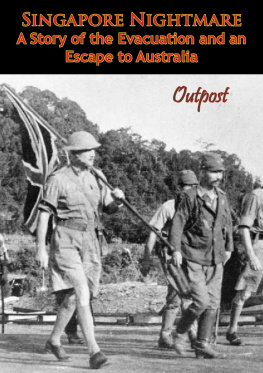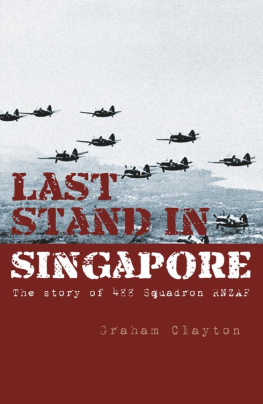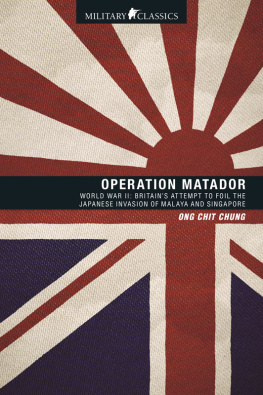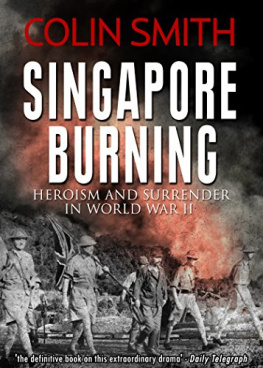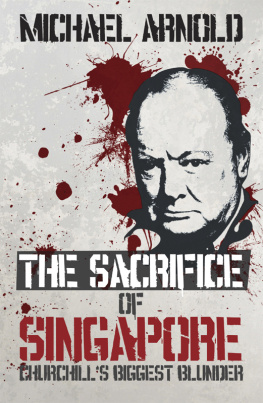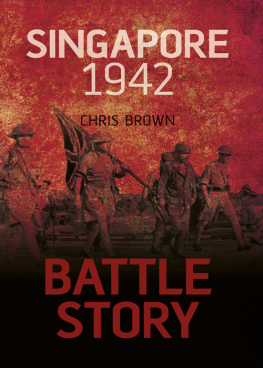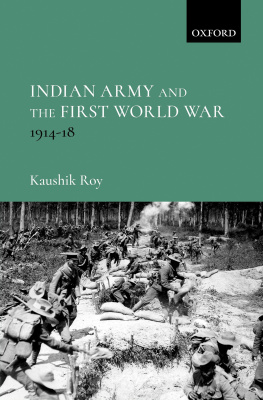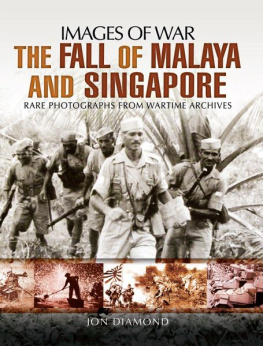

This edition is published by PICKLE PARTNERS PUBLISHINGwww.pp-publishing.com
To join our mailing list for new titles or for issues with our books picklepublishing@gmail.com
Or on Facebook
Text originally published in 1943 under the same title.
Pickle Partners Publishing 2016, all rights reserved. No part of this publication may be reproduced, stored in a retrieval system or transmitted by any means, electrical, mechanical or otherwise without the written permission of the copyright holder.
Publishers Note
Although in most cases we have retained the Authors original spelling and grammar to authentically reproduce the work of the Author and the original intent of such material, some additional notes and clarifications have been added for the modern readers benefit.
We have also made every effort to include all maps and illustrations of the original edition the limitations of formatting do not allow of including larger maps, we will upload as many of these maps as possible.
SINGAPORE NIGHTMARE
BY
OUTPOST
A STORY OF THE EVACUATION AND AN ESCAPE TO AUSTRALIA
The photographs have been kindly loaned by the
Malaya Information Bureau
TABLE OF CONTENTS
Contents
PUBLISHERS NOTE
THIS is the story of magnificent endeavour and frustrated valourthe story of Singapore. Singapore Nightmare arrives in London at the moment when we expect, as Field-Marshal Smuts said, the defence phase has now ended, the great offensive moment is ripening.
Singapore Nightmare shows to what lengths our enemies will go to conquer and humiliate the free nations, and just how prepared in every detail we must be.
War in the Far East has equalled in terror the war of the West, and as the censor has so wisely said in his preamble, when passing the manuscript, As author has identified by name an officer who befriended him, and discusses the nature of the officers duties, it is suggested that the said officers name be changed. It is considered that the enemy may take reprisals against the officer and his family.
For this reason we have changed certain names and given the authorwho is an Englishman holding down an Empire jobthe nom de plume of Outpost, otherwise the story is published unadorned and unabridged.
CHAPTER IINVASION
ON 1 st December, 1941, I received a letter in my morning mail telling me that I had to report to Volunteer Headquarters in Beach Road, Singapore, at 6 a.m. on Wednesday, 3 rd December, this being the third day of mobilization.
This was the first intimation of war in Malaya, and I would never have believed it if someone had told me that less than three months later Singapore would have fallen and that I would be escaping across Sumatra.
Most civilians in Singapore had been active members of different Volunteer Forces since the European War had started, and I personally had been a Volunteer for the past five years. Before the war we used to do only one parade a week, with one or two weekend camps during the year, but when the war started in 1939, we had greatly increased the number of camps and parades with a special annual two-months training period, during which time we were attached to the regular British Forces. This two-months period was intensive training, and when the Japanese attacked Malaya we felt as efficient and as highly trained as any other unit of the regular Defence Force.
All Volunteers in Singapore received their mobilization notices on that Monday, and they all had to report on various days, ranging from 2 nd December to 5 th December, when mobilization was supposed to be complete. Most of the Volunteers left their offices immediately they received their notices, and proceeded to arrange their private affairs. I did the same, and when I reported on Wednesday morning I knew that I had done everything possible for my wife and children should I never see them again.
That Wednesday morning I joined my section of the Singapore Royal Artillery, and we took over our two Eighteen-pounder guns and our searchlight.
Volunteer Headquarters had never been such a hive of activity, yet everything went off very smoothly. Our guns were hooked on to two lorries, and off we rattled at ten miles an hour to our pre-arranged position on a Singapore beach. At Headquarters the opinion was expressed on all sides that if the Japanese wanted to fight we were more than a match for them, and there was much light-hearted badinage.
Our section consisted of fourteen men under an officer and four N.C.Os., and when we arrived at our gun position we worked until midnight getting things into position. About midnight our ammunition arrived and, dog-tired as we were, it was necessary to unload it. Most of us were office-workers and more used to sitting in chairs asking other people to work, so it can be imagined how we felt. However, nobody grumbled, although we were a weary-looking lot the next morning.
There was plenty to do on our gun position, and although so far nothing had happened we all knew that sooner or later the Japanese would attack Malaya, although none of us thought that they would bomb Singapore as easily as they did a few mornings later.
Our next few days were occupied with digging slit trenches, erecting barbed wire fences, and generally strengthening our gun position.
We lived in an old shack a few yards away from our gun positions, and a welcome addition to our ranks was a Chinese cook and assistant. Army rations were issued to us daily, but we found it necessary to supplement these by clubbing together and buying extra food and fruit.
About 3 a.m. on Monday morning, the 8 th December, I woke up and heard crunch! crunch! crunch! in the distance. I thought to myself those are bombs! and at that moment the air-raid sirens started sounding their warning. We dived out of our beds into our gun-pits, and as we ran we noticed that the sky was ablaze with searchlights. The searchlights soon picked up a target and the guns started firing, but couldnt hit it, and, in a few minutes, the sound of aeroplanes died away. We were amazed to see that the street lights of Singapore were full on everywhere, and shortly we heard the clang of fire engines as they raced to the places-where the bombs had fallen. We were all in position for the rest of the night in case of a naval attack or further bombings, but nothing happened, except that one Volunteer found out when he went to obey a call of Nature that in his excitement he had put his trousers on back to front!
At daylight lorries started arriving loaded with the remnants of bombed houses, and when we saw a severed leg sticking out of the dbris we realized that this had been no mock attack.
Later in the day we found out that the first bomb had fallen into Raffles Place, the heart of the shopping centre of the town, and had damaged the new premises of Robinson & Co., a well-known departmental store. Another, bomb had fallen a quarter of a mile away from my home demolishing a small house, while a few others had fallen in different parts of the town. The greatest number of casualties were caused by a bomb which fell on a Chinese lodging-house in a crowded part of the Chinese quarter.
While we were working on our beach-post, digging a slit trench, I looked out to sea and there, barely zoo yards away, we saw the Repulse and the Prince of Wales slowly and majestically moving out on what proved to be their last voyage. The decks were lined with the crews and their bands were playing. It was a wonderful sight, and we all freely expressed our opinions that they would soon make short work of the Japanese when they got near them! Imagine our consternation and dismay when news came through that they had both been sunk! Later I met some of the crew who, after being rescued, had been sent up to Penang to work the ferry-boats from Penang Island to the mainland during the evacuation of Penang, after many of the original Malay crews had deserted and run away.
Next page
